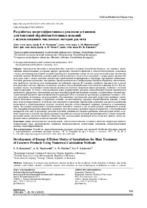Разработка энергоэффективных режимов установок для тепловой обработки бетонных изделий с использованием численных методов расчета

Date
2021Publisher
Another Title
Development of Energy-Efficient Modes of Installations for Heat Treatment of Concrete Products Using Numerical Calculation Methods
Bibliographic entry
Разработка энергоэффективных режимов установок для тепловой обработки бетонных изделий с использованием численных методов расчета = Development of Energy-Efficient Modes of Installations for Heat Treatment of Concrete Products Using Numerical Calculation Methods / В. Н. Романюк [и др.] // Наука и техника. – 2021. – № 3. – С. 195-206.
Abstract
Производство бетонных и железобетонных изделий в условиях Республики Беларусь и в странах с аналогичными климатическими условиями требует проведения тепловой обработки в теплотехнологических установках с целью достижения продукцией заданной прочности в назначенное время, на что расходуется большое количество тепловой энергии. Назначение режимов работы оборудования в этом случае сопряжено с целым рядом трудностей, когда речь идет о новых изделиях сложной пространственной конфигурации и структуры. Критериями оптимальности таких режимов выступают, как правило, продолжительность и температурные пределы обработки, обеспечивающие требуемую прочность при минимальном потреблении энергии. В условиях серийного производства в случае конструктивно простых объектов назначение режимов тепловой обработки осуществляется опытным путем. Как показывает анализ, полученные таким образом режимы не отвечают названным выше критериям, особенно с позиций энергосбережения. В статье с использованием ранее разработанной авторами математической модели предлагаются зависимости для расчета оптимальных режимов тепловой обработки бетонных изделий, отличающихся сложной пространственной формой и многокомпонентной структурой. Метод основан на трехмерных уравнениях переноса с учетом внутренних источников тепловыделений, обусловленных протекающей реакцией гидратации активных компонентов цементного клинкера, и граничных условий, соответствующих структуре обрабатываемого изделия, а также виду теплотехнологического устройства для ускоренной гидратации. Предложены уравнения для расчета количества подводимой к обрабатываемому изделию тепловой энергии, обеспечивающей заданную прочность в назначенное время. На примере выпускаемого промышленного бетонного изделия и для условий реально применяемого устройства ускоренной гидратации выполнено сравнение двух предельных режимов тепловой обработки: с изотермической выдержкой и без нее. В результате расчетов получены зависимости энергопотребления, температурных полей и степени гидратации в изделии для обоих режимов и разработан соответствующий рассматриваемому случаю энергосберегающий режим тепловой обработки. Показано, что используемый численный метод позволяет решать задачи подобного типа и добиваться экономии тепловой энергии.
Abstract in another language
Production of concrete and reinforced concrete products in the conditions of the Republic of Belarus and in the countries with similar climatic conditions requires heat treatment in heat-technological installations in order to achieve the desired strength of the products at the appointed time, which consumes a great amount of thermal energy. In this case, the purpose of equipment operating modes is associated with a number of difficulties when it comes to new products of com-plex spatial configuration and structure. The optimality criteria of such modes are, as a rule, the duration and temperature limits of processing, providing the required strength with minimal energy consumption. In the conditions of serial production in the case of structurally simple objects, the assignment of heat treatment modes is carried out empirically. As the analysis shows, the modes obtained in this way do not meet the above criteria, especially from the standpoint of energy saving. The paper, using a mathematical model previously developed by the authors, proposes dependencies for calculating the optimal modes of heat treatment of concrete products that are distinguished by a complex spatial shape and multi-component structure. The method is based on three-dimensional transfer equations, taking into account internal sources of heat release due to the ongoing hydration reaction of the active components of the cement clinker, and the boundary conditions cor- responding to the structure of the processed product, as well as the type of heat technology device for accelerated hydration. Equations are proposed for calculating the amount of heat energy supplied to the processed product providing a given strength at a specified time. On the example of a manufactured industrial concrete product and for the conditions of an actually used device for accelerated hydration, a comparison has been made between two limiting modes of heat treatment: with isothermal exposure and in its absence. As a result of the performed calculations, the dependences of energy consumption, temperature fields and the degree of hydration in the product for both modes have been obtained and an energy-saving mode of heat treat-ment corresponding to the case under consideration has been developed. It is shown that the used numerical method allows to solve problems of this type and to achieve thermal energy savings.
View/
Collections
- № 3[10]
